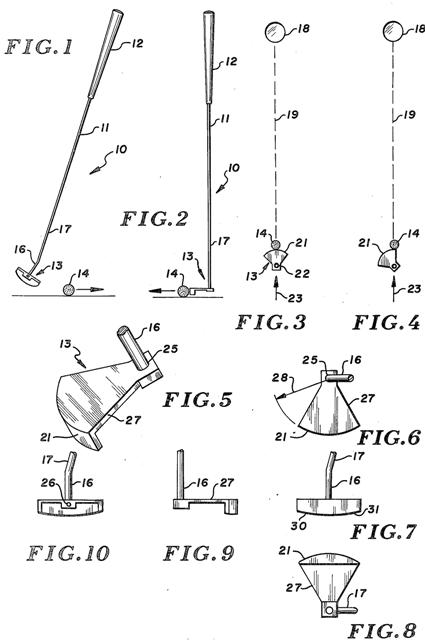Trouble Getting Your Putter Face Square at Impact?
If so, this putter may be for you!

The patent goes on to explain:
BACKGROUND OF THE INVENTION
The present invention relates generally to an improved golf putter, and more particularly to an improved golf putter structure which permits putts to be completed which are directionally accurate, in spite of inadvertent twisting of the face of the club during the stroking operation.
Most golfers experience problems with their putts from time to time. Frequently the problems can be attributed to an inadvertent twisting of the shaft during the completion of the stroke, with such inadvertent twisting of the club shaft providing an inaccurately directed putt. Generally, putters are provided with a substantially planar ball striking surface, although some putters have been designed with somewhat modified or curved configurations.
SUMMARY OF THE INVENTION
In accordance with the present invention, a putter is provided with a ball striking head which includes a ball striking surface along one face thereof. The ball striking surface has the general configuration of a cylindrical segment of substantially constant radius, thereby enabling the golfer to accommodate such inadvertent twists of the golf club without adversely affecting the directional aspects of the putt. Accordingly, if the golfer inadvertently twists the golf shaft during the putting stroke, such twisting will have no affect upon the directional aspect given to the golf ball upon being struck by the ball striking surface of the putter. In other words, the ball striking surface will always provide a proper direction of drive to the ball, in spite of any inadvertent twisting of the shaft, which would otherwise adversely affect the directional aspects of the putt if a conventional or even slightly modified ball striking surface were provided.
More specifically, the golf putter of the present invention has a ball striking head which is adapted to engage the club shaft, and furthermore which has a ball striking surface remotely disposed from the point at which the shaft engages the head. The ball striking surface, as previously indicated, is preferably in substantially the form of a cylindrical segment of substantially constant diameter, and furthermore the axis of the cylindrical segment forming the ball striking surface intersects a plane extending through the axis of said shaft along said gripping handle portion and generally parallel to a plane tangent of said ball striking surface at the arcuate center thereof. For most golfers, the magnitude of the radius of arc from the axis of the shaft engaging zone to the surface is between 2-1/2 inches and 3 inches, although radii of up to about 4-1/2 inches may be useful, with a preferred radius being approximately 3 inches. Such a radius appears to be universally acceptable for golfers, and is of a magnitude which accommodates the normal inadvertent twisting which plagues most golfers from time to time.
Mock one of these up and let me know how many putts per round it cost you.
Dave Dawsey – The Putter Invention Lawyer
PS – Click HERE to get your fill of putter inventions.
